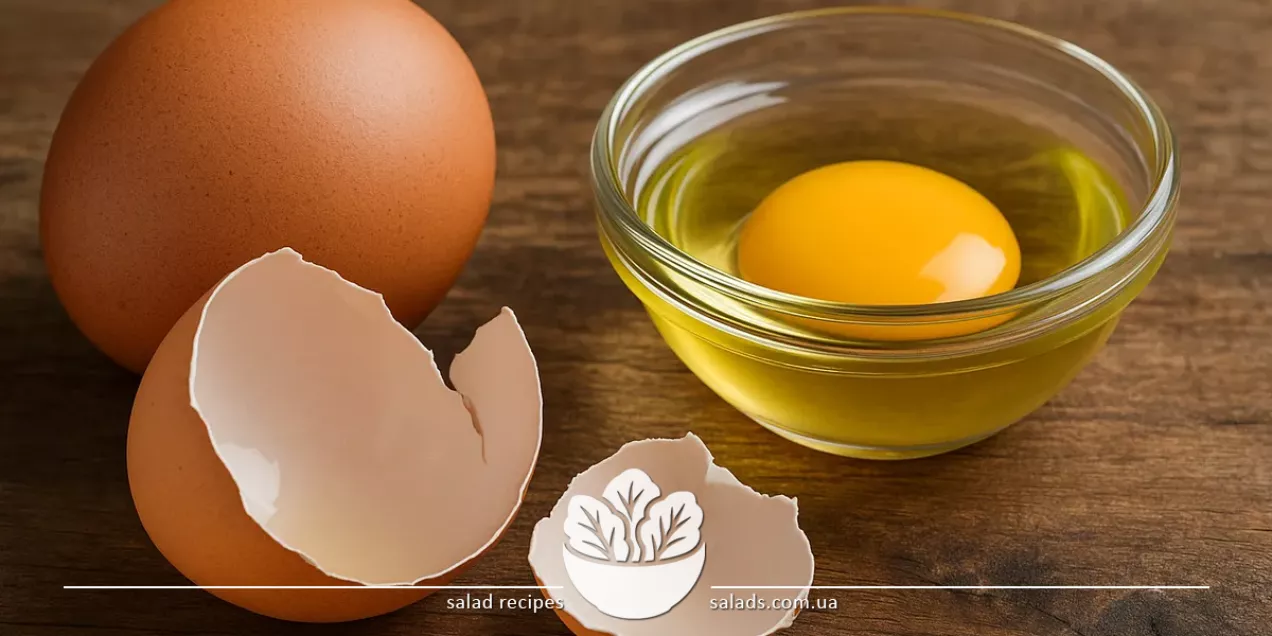
Chicken Egg

Chicken egg is a natural source of protein, fats, vitamins, and minerals that plays a key role in both cooking and nutrition. Eggs are used as a standalone product and as a necessary component for dough, creams, cutlets, casseroles, salads, and many other dishes. With thickening, emulsifying, and binding properties, eggs are technically important in recipes. Separating the yolk from the white opens even more options for confectionery and culinary creativity. More about types of chicken eggs can be found in the catalog.
Salad Recipes with Chicken Eggs
Nutritional Value and Health Benefits
Chicken eggs offer a natural complex of proteins, fats, vitamins, and minerals in a compact and bioavailable form. On average, one egg contains about 6-7 grams of complete protein, all essential amino acids, B, D, A, E vitamins, and trace elements such as iron, phosphorus, selenium, and zinc. The yolk contains lecithin, which supports liver and nervous system function, and choline, important for brain health. Despite previous concerns about cholesterol, modern research shows that moderate egg consumption is not only harmless but also beneficial for cardiovascular health. Eggs are frequently included in athletic, dietary, and children's meal plans as a source of quick, easily digestible protein. They can be eaten boiled, fried, poached, as omelets or casseroles. Combining eggs with other nutritious ingredients ensures a long-lasting feeling of fullness. A classic example is breakfast with smoked ham, where the egg's protein is complemented by meaty flavor, and its richness offers a high-energy meal.
Use in Salads and Appetizers
Chicken eggs are a key ingredient in many salads and cold appetizers. Boiled eggs add texture, protein density, and a soft, creamy flavor that pairs well with nearly all ingredients. They may be cubed, sliced, grated, or served as halved pieces for decoration or flavor balance. In classic recipes, eggs are often combined with boiled vegetables, greens, cured meats, mayonnaise, or yogurt-based dressings. They play an important role in such popular dishes as "Olivier", "Mimosa", and salads with cod liver, crab sticks, or chicken. In vegetarian recipes, eggs compensate for the lack of meat protein, making meals complete and nourishing. A well-balanced salad often includes boiled egg and fresh cucumber. The contrast between the egg's softness and the cucumber's crunch, along with its neutral, refreshing taste, makes this combination ideal for light summer meals and snacks.
Eggs in Seafood Dishes
Chicken eggs are commonly used in seafood dishes, where they act as a binding component, enhance the protein base, or add a gentle contrast in texture and flavor. Thanks to their delicate taste, eggs do not overpower seafood aromas but instead highlight their tenderness. This approach is especially valued in recipes with squid, shrimp, crab meat, or fish. Eggs can be served boiled (in salads or appetizers) or raw – as omelets, soufflés, or baked fillings. For instance, a frittata with squid, egg, and herbs is a perfect protein-rich meal for lunch or dinner. Eggs are also used in fish patties as a binding element that maintains the mixture’s structure. They pair particularly well with frozen squid, which has a tender, nearly neutral texture that benefits from a soft companion. In such dishes, the egg fulfills both nutritional and functional roles, providing proper consistency and added satiety without unnecessary additives.
Breakfasts and Quick Egg Dishes
Chicken eggs are an excellent choice for a quick, nutritious, and versatile breakfast. They cook in just a few minutes and can be boiled, fried, made into omelets, scrambled eggs, or poached. Thanks to their rich protein content and natural fats, eggs provide a lasting feeling of fullness and supply essential micronutrients early in the day. Eggs pair well with bread, greens, vegetables, meats, and cheese. For example, an omelet with ham and cheese is a classic quick-cooking option requiring no complex ingredients. A boiled egg can be added to a sandwich or placed on toast – improving the nutritional balance and enhancing flavor. Eggs pair especially well with fresh herbs, and the most universal of them is green onion. It enhances the egg’s aroma, adds freshness, and a light piquant note. This duo is the foundation of simple yet tasty and balanced breakfasts: scrambled eggs with onions, omelets, sandwiches, or even stuffed pancakes.
Eggs in Holiday and Traditional Dishes
Chicken eggs are the base of many traditional and festive dishes, particularly in Ukrainian cuisine. They are used not only as ingredients but also as symbols of fertility and new beginnings – especially in Easter meals. Eggs are boiled, dyed, baked, added to salads, fillings, meat rolls, and baked goods. They provide structure, protein, and an appetizing appearance. In festive menus, eggs most often appear stuffed – with pâté, mushrooms, sprats, red fish, or cheese. They’re also added to meat rolls, aspics, and casseroles. Due to their protein content, eggs harmonize well with vegetables, creating dishes suitable for both everyday and special occasions. A classic example is layered salads, where eggs play a vital role. One of the best-known versions features beetroot, boiled potatoes, carrots, onions, eggs, and mayonnaise. The egg adds tenderness and nutrition, while the beetroot contributes color, sweetness, and character. This combination is known in both modern and traditional recipes.










